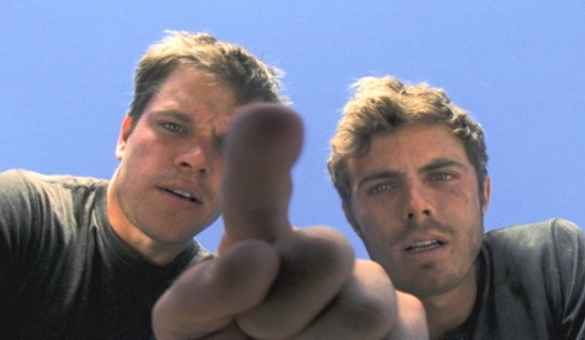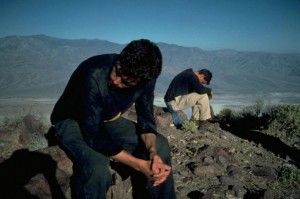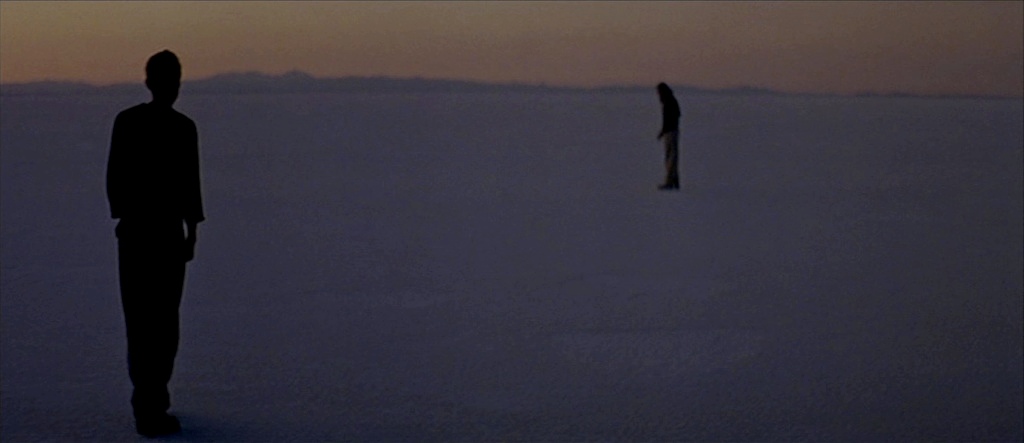
<blockquote><em>“How do you think the hike’s going so far?”</em> – Gerry</blockquote>
Meditative, arty, beautiful, hypnotic, tense-filled… and willfully testing of your patience. <em>Gerry</em> will be maddening to those looking for quick fixes. We all crave doses of accessible commercial entertainment that delivers instant interpretable information within seconds. You have to be one who meditates, one that spends minutes lingering on profound ideas and can wait until the film’s end, or until hours after the film’s end, to find your deliverance. Matt Damon and Casey Affleck star, there are no other notable actors. Only a few other specks of extras. Gus Van Sant (“Drugstore Cowboy,” “Paranoid Park”) directs at his most experimental, and I think it is his greatest film.
The common viewing complaint is that nothing happens. The philosophical power of the film is the foreboding fear of something soon to happen, whether it be good or bad.
Films have no right to be this slow, not unless they are as beautifully framed, methodical, and visually poetic as this one. With an eye for stark desolation, like an Ansel Adams painting in motion, the work by cinematographer Harris Savides it is one of the best photographed films ever shot. Savides (1957-2012) would work with Van Sant six times including the Oscar-winning “Milk” (2008) and the Cannes Palm d’Or winner “Elephant” (2003).
In what was a personal “I-don’t-give-a-damn-if-it-makes-money” film by Van Sant, we are supposed to be mesmerized by the images first, drawn into the mood of dread second. Damon and Affleck are a couple of detached American jocks (read: emotions at arm’s length) who go off the trail on a nature hike in Death Valley, and when they turn around, they can’t find their car. This is a nuisance, but a tolerable one for they will set up camp and continue to search for their ride home the next day. They reach a high crest only to realize they not only don’t have their car is sight but have lost their sense of direction.
A lost in nature film this is, with extended tracking shots. Stanley Kubrick used these kinds of shots of characters reticently moving down corridors in “The Shining” or soldiers marching towards oblivion in “Full Metal Jacket.” The whole detached ennui feel was the tonal chord of Michelangelo Antonioni’s “L’Avventura” (1960), and so it is here. Van Sant is himself a master of mood and tone matching meticulously with his visual choices. Shooting carefully, <em>Gerry</em> is made up of 100 shots total, period.
Slowed to a lurch for its conclusion, <em>Gerry</em> has gotten slower and slower but alas, it also gets eerie with its brink of death and edge of desolation aura. Who are these young guys to each other? We know they are buddies, but it’s not fully clear who they are to each other until they’ve come to the hour of their limitation when, only then, do they succumb to a final pitiful bond. And what’s crazy on a philosophical level is that the nature they have trekked is two-sided: it is both alternately heaven and hell.
I don’t like the two characters that River Phoenix and Keanu Reeves play in <em>My Own Private Idaho</em>, I pity them. I look at them with pitiful detachment in Gus Van Sant’s surreal portrait of life on a bare bones drift. They have sex for money in several instances. And prostitution, it seems, kills any enduring enjoyment of sex itself. There is no closeness, no intimacy. Just sex deduced to a superficial transaction and arbitration. That’s sad.
What’s frustrating, however, is the listlessness of the film itself. I hate to say it, but there are so many pretentious transitions to the film (we go from Idaho to Seattle to Portland to… Rome?), that I could not get into the why’s of what the characters were going through. Or the how’s.
Much about Van Sant’s style is elliptical, to a disconcerting degree. I got a portrait of homelessness and desolation and despair and desperation, alright. But not a narrative I could latch onto. Per case, I found it to be a chore to watch. Despite intervals of impressive moments such as cranked up images of clouds rolling over fields or a rare fraternal moment of the duo on a motorcycle together.
“How do you think the hike’s going so far?” – Gerry
Meditative, arty, beautiful, hypnotic, tense-filled… and willfully testing of your patience. Gerry (2003) will be maddening to those looking for quick fixes. We all crave doses of accessible, commercial entertainment that delivers instant interpretable information within seconds. You have to be one who meditates, one that spends minutes lingering on profound ideas and can wait until the film’s end, or until hours after the film’s end, to find your deliverance. Matt Damon and Casey Affleck star, there are no other actors. Only a few other specks of extras. Gus Van Sant directs at his most experimental. The common viewing complaint is that nothing happens. The philosophical power of the film is the foreboding fear of something happening, whether it be good or bad.
Movies have no right to be this slow, not unless there as beautifully framed, methodical, and visually poetic as this one. With an eye for stark desolation, like an Ansel Adams painting in motion, the work by cinematographer Harris Savides it is one of the best photographed films ever shot. Savides (1957-2012) would work with Van Sant six times including the Oscar-winning “Milk” (2008) and the Cannes Palm d’Or winner “Elephant” (2003).
 In what was a “personal” I-don’t-give-a-damn-if-it-makes-money film by Van Sant, we are supposed to be mesmerized by the images first, drawn into the mood of dread second. Damon and Affleck are a couple of detached American jocks (read: emotions at arm’s length) who go off the trail on a nature hike in Death Valley, and when they turn around, they can’t find their car. This is a nuisance, but a tolerable one for they will set up camp and continue the search the next day. They reach a high crest only to realize they not only don’t have their car is sight but have lost their sense of direction.
In what was a “personal” I-don’t-give-a-damn-if-it-makes-money film by Van Sant, we are supposed to be mesmerized by the images first, drawn into the mood of dread second. Damon and Affleck are a couple of detached American jocks (read: emotions at arm’s length) who go off the trail on a nature hike in Death Valley, and when they turn around, they can’t find their car. This is a nuisance, but a tolerable one for they will set up camp and continue the search the next day. They reach a high crest only to realize they not only don’t have their car is sight but have lost their sense of direction.
A lost in nature movie with extended tracking shots. Stanley Kubrick used these kinds of shots of characters reticently moving down corridors in “The Shining” or soldiers marching towards oblivion in “Full Metal Jacket.” The whole detached ennui feel was the tonal chord of Michelangelo Antonioni’s “L’Avventura” (1960), and so it is here. Van Sant is himself a master of mood and tone matching meticulously with his visual choices. Shooting carefully, “Gerry” is made up of 100 shots total, period.
Slowed to a lurch for its conclusion, “Gerry” has gotten slower and slower but alas, it also gets spookier. Who are these young guys to each other? We know they are buddies, but it’s not fully clear who they are to each other until they’ve come to the hour of their limitation when, only then, do they succumb to a final pitiful bond. And what’s crazy on a philosophical level is that the nature they’ve trekked is two-sided: it is both heaven and hell.
103 Minutes. Rated R.
Film Cousins: “L’Avventura” (1960, France); “Walkabout” (1971); “127 Hours” (2010); “The Loneliest Planet” (2012).






